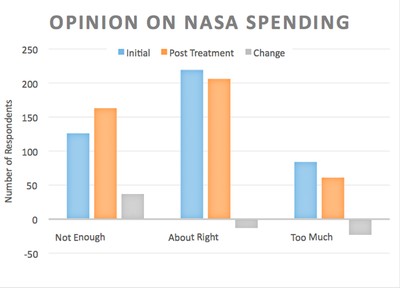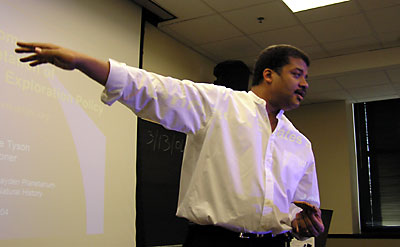Testing the Neil deGrasse Tyson Effectby Alan Steinberg
|
| Neil deGrasse Tyson’s space evangelism works, but perhaps that the message has just not yet reached a sufficient amount of people. |
Subjects were then asked to identify NASA’s budget as a percentage of the federal budget. They were given these choices: 0.1%, 0.5%, 1%, 5%, 10% and 25%.2 In the initial round of assessment, 294 respondents (68.4 percent) overestimated NASA’s budget as a percent of the federal budget by at least double the actual value, of which 224 respondents (52.1 percent) overestimated NASA’s actual budget by at least tenfold. This implies that people think NASA is getting a much larger slice of the federal pie than it actually is. While these findings are as expected, the question becomes, what can be done about it?
Survey respondents were later told the words Neil deGrasse Tyson has said time and time again: “NASA’s budget is currently 0.6 percent of the federal budget, i.e., about half a penny per tax dollar.” Following this fact they were then asked how they felt about the current level of federal spending on NASA using the same metrics. In this post-treatment round 61 respondents felt space spending was too much, 206 about right, and 162 not enough. The post treatment mean was 0.237 with a standard deviation of 0.682.
The graph bellow visually represents the changes, where it can be seen that after the treatment a large proportion of the sample changed their opinion, with more people now feeling that federal spending for NASA is not enough. The statistical evidence for the change can be evaluated though a test of the initial and post-treatment values. A calculation of a difference of means test provides t-value of 2.975 and subsequent p-value of 0.003. Therefore, educating respondents on the actual level of NASA’s budget leads to a statistically significant increase in overall support for NASA spending.
 |
This study thus confirms, and the data shows, a 29 percent mean increase for support for additional NASA spending after being individuals are educated on the reality of NASA’s budget as a percentage of the federal budget.3
While this is just one small test, and the sample is limited to college students, respondents in the sample are demographically representative to the public in regards to income and political leanings. This suggests that Neil deGrasse Tyson’s space evangelism works, but perhaps that the message has just not yet reached a sufficient amount of people.
Footnotes
1 According to the Office of Management and Budget, the total 2012 Federal budget was $3,537 Billion and NASA’s budget was $17.8 Billion. For the complete document see: Office of Management and Budget, “Fiscal Year 2014 Budget of the U.S. Government,”; Budget.gov (accessed 3 September 2013).
2 The choices to use these percentages were based upon questions found in prior surveys of NASA budgetary knowledge.
3 Complete data available upon request.
